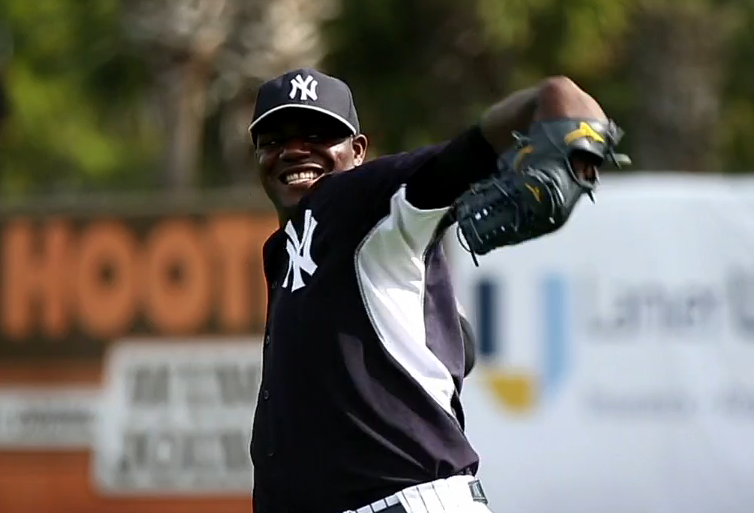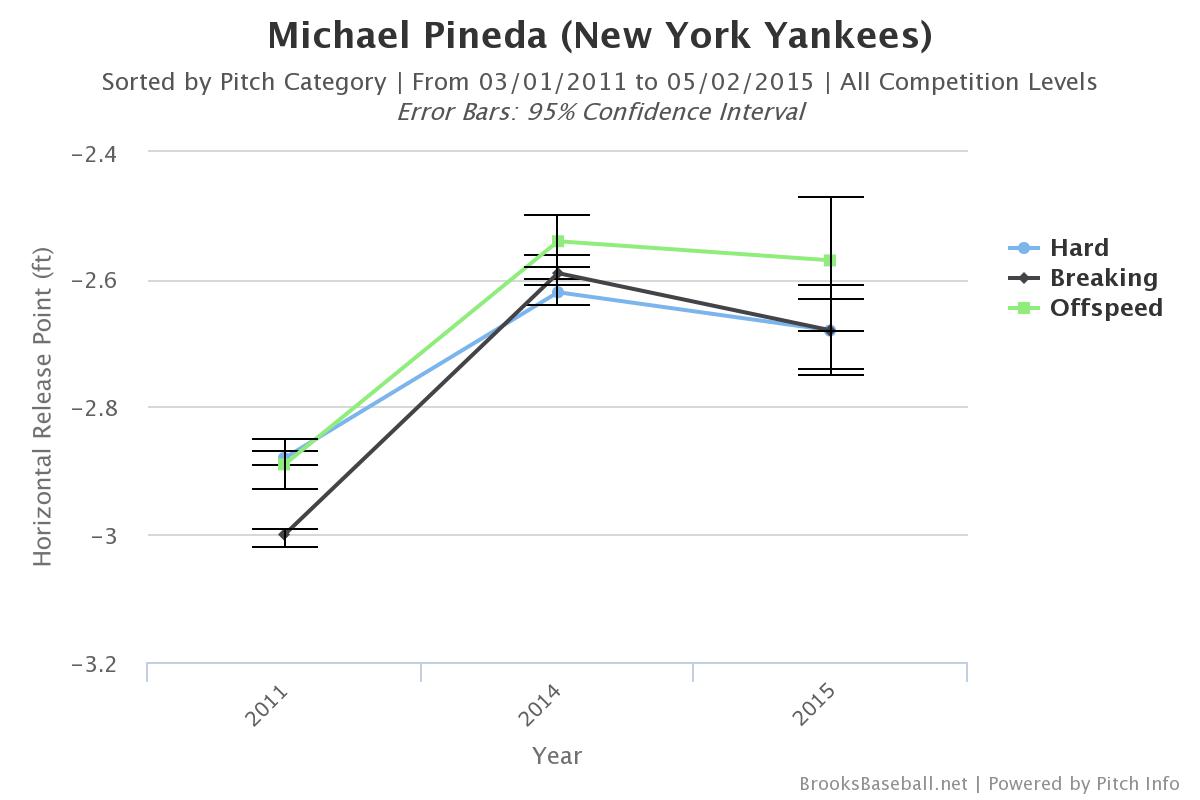On January 13th, 2012, the New York Yankees and the Seattle Mariners combined for one of the more shocking blockbuster trades in recent memory. The Yankees, flush with hitting, traded the position-less masher Jesús Montero for Michael Pineda of the Mariners, one of their many promising young pitchers. It played out like a classic elementary school lunchtime food swap; the Yankees had an extra juicebox but no food, the Mariners an extra sandwich but no drink. The trade was a rare prospect-for-prospect deal, but it made sense for each side. If Pineda and Montero both developed concordantly, both teams would be better off with the player they received.
Three and a half years later, it’s safe to say things didn’t go according to plan on either side. Montero played promisingly in 2012, hitting .260 with 15 home runs and 61 RBI’s. Since then he’s split his time between the big league club, the minors, the disabled list, and 50 games on Bud Selig’s naughty list for his involvement in the Biogenesis scandal. From the Yankees perspective the trade looked even worse as recently as last spring. Pineda missed all of 2012 and 2013 with right shoulder injuries and came into camp last year as a complete mystery. He again spent a good chunk of last year on the shelf with more shoulder injuries and serving a minor suspension for some tomfoolery (the pine tar incidents), but he managed to pitch 76 innings with a 1.89 ERA.
If each player retired on the spot today, we might call this one a draw. But as far as I’ve heard that’s not happening and the Yankees look poised to win the trade over the long haul. Michael Pineda showed a lot of promise last year and is healthy for the moment, while Jesús Montero can’t rid himself of the “AAAA” label on his bat.
Two starts into 2014 and nearing the 100-inning plateau in pinstripes, it seems like as good a time as any to evaluate Michael Pineda. We’ve seen enough from him since his shoulder injuries to get a good idea what type of pitcher he will be as a Yankee. For better or worse, he is not the same guy he was that first summer in Seattle. So let’s take a trip down memory lane. The year: 2011, the city: Seattle, the music: fitting.
Note: the data included is from Brooks Baseball, a partner of Baseball Prospectus.
Mariner Mike: A Two-Pitch Power Arm
When he broke into the league in 2011 with the Mariners, Michael Pineda pitched like a typical 22-year-old; he relied on what had gotten him there. For Pineda specifically, this meant throwing his fastball and slider, two dominant pitches, almost 95% of the time. He rode these two pitches to a breakout first half (8-5 with a 2.58 ERA on July 4th) and an all-star nod as a rookie.
| Pitch | Usage | Average Velocity | Horizontal Movement* | Vertical Movement** |
| Fourseam Fastball | 61.26% | 95.44 mph | -4.25″ | 8.80″ |
| *negative is run, positive is cut **negative is down, positive is up | ||||
In Seattle, the four-seam fastball was Pineda’s favorite pitch. His fastball had great velocity and great tailing movement (in to a righty). He could throw it in any count against right-handed or left-handed hitters and the subtle, late run on the pitch prevented hitters from squaring it up. Pineda moved it up and down, in and out, ringing up strikeouts and using it to set up his other main offering, the slider.
| Pitch | Usage | Average Velocity | Horizontal Movement* | Vertical Movement** |
| Slider | 31.65% | 84.68 mph | 2.35″ | 0.47″ |
| *negative is run, positive is cut, **negative is down, positive is up | ||||
His hard slider was filthy, especially paired with 95 mph heat at the belt. Batters were flailing all year at the pitch, and for good reason. It too had fantastic late movement, diving at the foot of left-handed hitters and off the table for right-handed hitters. Batters whiffed at Pineda’s slider an absurd 20% of the time he threw it in 2011. The fastball and slider were his bread and butter, his pasta and marinara, his baa-gel and cream cheese.
| Pitch | Usage | Average Velocity | Horizontal Movement* | Vertical Movement** |
| Sinker | 0.84% | 94.91 mph | -8.51″ | 4.50″ |
| Changeup | 6.22% | 88.37 mph | -8.55″ | 5.38″ |
| *negative is run, positive is cut, **negative is down, positive is up | ||||
Pineda also very occasionally used a changeup to keep hitters honest, though throwing it only 6% of the time kept them about as honest as a Bluth. And the sinkers that PITCHf/x thought it tracked may have just been wild fourseam fastballs, recording only 23 of them all year. I couldn’t locate video of either pitch back then so we’ll have to believe that at best, the changeup was a work in progress.
Relying so heavily on two pitches, no matter how great they are, is a strategy usually reserved for relief pitchers who see only a part of a lineup each game. As a rookie, teams were facing Pineda for the first time and he shoved the fastball-slider combo down their throats, but in the second half he began to struggle. Some combination of better scouting reports, a lack of a third pitch, and general fatigue caught up with Mariner Mike and his ERA jumped up one whole run the last two months of the year.
That being said, there was a lot of promise and strikeout-potential in his young arm, enough to convince the Yankees to acquire him.
2014 Yankee Mike: Less Power, More Refinement
One of the first things I noticed when I saw Pineda pitch his first game in New York last year was how different his stuff looked from what I remembered. In my mind he was a huge dude with a blazing fastball. And he was still a huge dude but the fastball had lost some of its oomph. He was being a lot more precise with his pitches and…wait…was that a cutter?
Mariner Mike reminded me of Joel Zumaya or Fernando Rodney but Yankee Mike reminded me of a much, much larger Dan Haren. Had Michael Pineda become Dan in real life? Had he changed as much as I thought?
| Pitch | Usage | Average Velocity | Horizontal Movement* | Vertical Movement** |
| Fourseam Fastball in 2014 | 54.92% | 93.29 mph | -0.64″ | 6.04″ |
| Difference from 2011 | -6.34% | -2.15 mph | +3.61″ | -2.76″ |
| *negative is run, positive is cut, **negative is down, positive is up | ||||
Yes! His fastball underwent a sea change during the three years it took him to get on the mound for the Yankees. He no longer threw as hard, didn’t throw his fastball as much, lost almost all of the horizontal run, and his fastball was dropping more than it ever had. Everything about the pitch had fundamentally changed. He became more precise, throwing 3% more strikes with his fastball last year than in 2011 though he wasn’t having as much success with a falling whiff rate. Depending on the situation, Pineda will sometimes even cut his fastball now, something he couldn’t dream of doing in Seattle.
| Pitch | Usage | Average Velocity | Horizontal Movement* | Vertical Movement** |
| Slider – 2014 | 34.10% | 84.67 mph | 4.53″ | -0.64″ |
| Difference from 2011 | +2.45% | -0.01 mph | +2.18″ | -1.11″ |
| *negative is run, positive is cut, **negative is down, positive is up | ||||
Pineda’s slider in 2014 might have been even filthier than it was back in his Seattle days. He has managed to maintain the velocity right around 85 mph and increased both the drop and sweep on the pitch. His slider is an improved weapon and last year Pineda’s catchers called the pitch nearly 35% of the time. Though the whiff percentage on the pitch has dropped a bit down to 17%, this is likely due to the smaller gap between the fastball and slider velocity.
| Pitch | Usage | Average Velocity | Horizontal Movement* | Vertical Movement** |
| Changeup in 2014 | 9.90% | 88.17 mph | -8.43″ | 5.08″ |
| Difference from 2011 | +3.68% | -0.20 mph | +0.12″ | -0.30″ |
| *negative is run, positive is cut, **negative is down, positive is up | ||||
Despite the numbers in this chart that would suggest otherwise, the changeup has been one of the biggest changes for Michael Pineda since he’s returned to the mound. Last year, before getting suspended and hurt in the middle part of 2014 his changeup was finally becoming a legitimate offering for him. While the movement is no different than it was in Seattle, his confidence in the pitch is growing and this season the trend has continued. Through two starts in 2015 the changeup has been his best pitch. He’s now throwing changeups almost 15% of the time and getting whiffs over 25% of the time.
What Happened?
The obvious question that this analysis elicits is WTF? Why the Face? How did Seattle Mike become Yankee Mike? Where did this big drop in velocity come from? And the answer is pretty equally clear: his shoulder. Pineda has suffered an extraordinary amount of injuries to his pitching shoulder in his young career and is now three years removed on his only completely healthy season. A combination of a chronically injured shoulder and the normal velocity drop that happens as pitchers age is the likely culprit for that velocity drop.
More interesting to me is the change in movement on Pineda’s fastball and slider. I suspect it also relates to his shoulder issues but in a more roundabout way.
It’s pretty well known that arm angles and release points help determine the trajectory of pitches. A pitcher who throws sidearm will naturally have a lot of run on a fastball and a frisbee-like slider (see Brad Ziegler or Pat Neshek). Similarly in order to throw a perfect 12-6 curveball a pitcher needs to throw more-or-less over the top.
Michael Pineda nearly eliminated the run on his fastball, adding the ability to throw a near-cutter and added a lot of horizontal movement on his slider the same way. I suspected that this change came as a result of a more over the top motion and vertical release point. Thanks to one of the coolest features of Brooks Baseball, I was able to put my hypothesis to the test.
Since coming to the Yankees and recovering from shoulder injuries, Pineda’s release point changed quite drastically. He now throws nearly a quarter of a foot more overhead and similarly closer to the body, most likely to relieve some stress he naturally put on his shoulder from his old arm slot. This change in release point could very well explain the change in movement we’ve seen on his pitches with the Yankees.
The Outlook
Yankee Mike is a much smarter pitcher than Mariner Mike. This at-bat with Chris Davis from his start on April 13th shows he’s mixing up his offerings better and using more creativity to make up for a loss in fastball velocity. Whether his newfound refinement is an improvement on his “here try to hit this” Seattle style remains to be seen, as does his health. But it is clear that he will be a key player for the Yankees in 2015 and if he keeps improving can be the best pitcher on the team.


